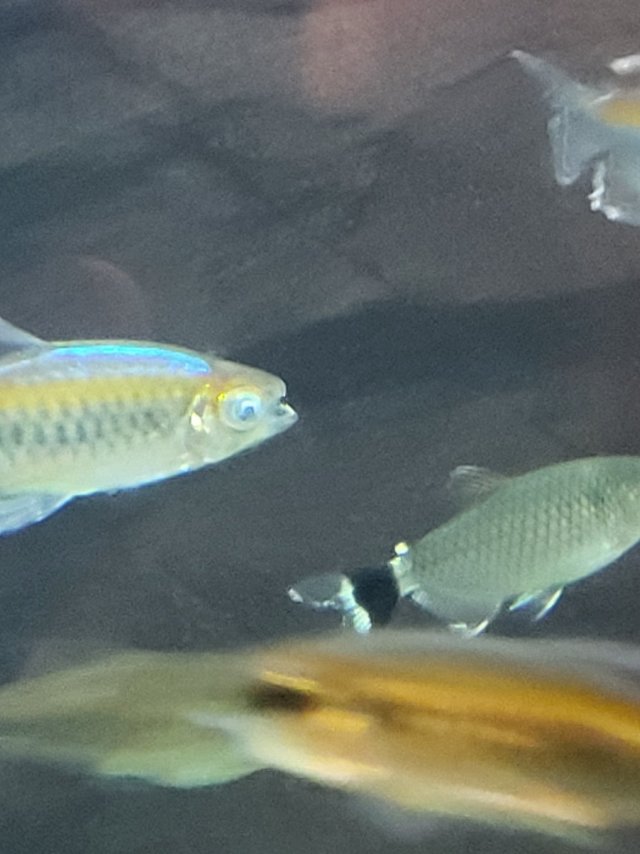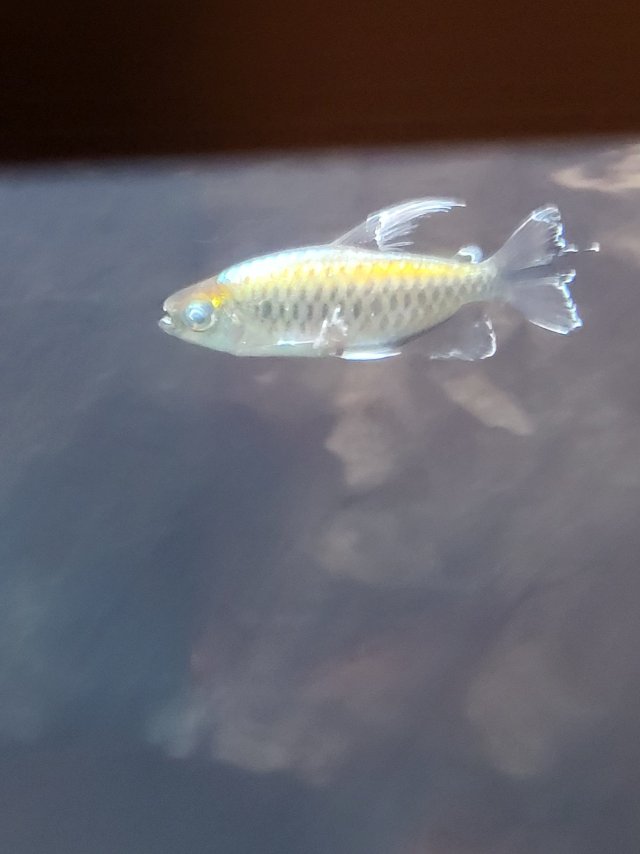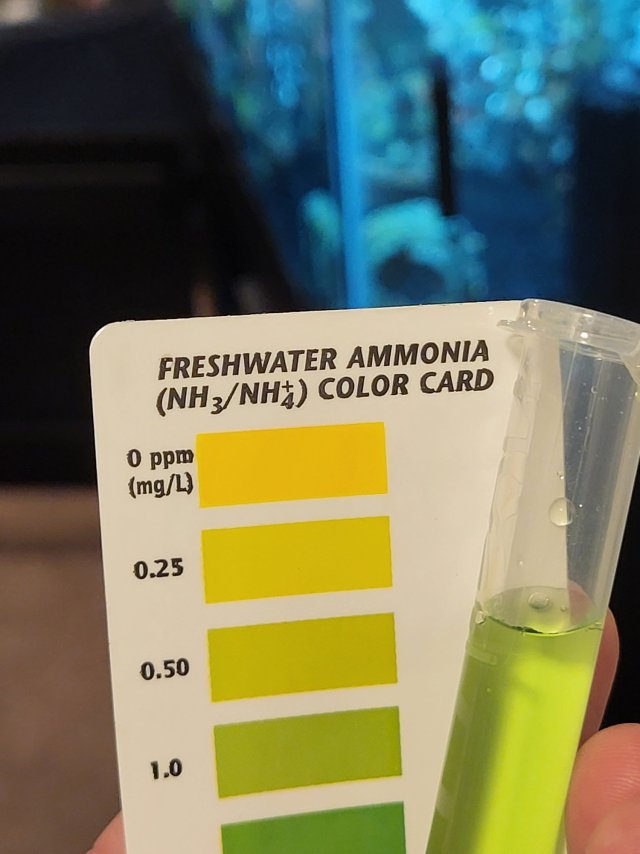I'm using a plethora of chemicals including Quick Start, Tap Water Conditioner, something for slime coat, and Stress Zyme. So with the fish in cycling should I keep doing water changes like mentioning? The ammonia is not at zero it's nitrates and nitrites. Also, the tank has been running for over a year.Hello; Beneficial bacteria (BB). Pages have been posted about them. As far as I know there is not a "for sure" over the counter product you can purchase to get BB.
They can be had for free but there are catches. The simplest way to get a starter culture is to grab some object which has been in an established tank for some time, like months or at least a few weeks. If your local fish shop is decent they might let you have some gravel, snails, used filter floss or something from one of their tanks. If you have a friend with tanks perhaps the same.
The BB are all around us. Start a bare tank filled with water and add a 1/4 cup of ammonia every day or two. Do this for a few weeks and you will have some BB colonies on surfaces in the tank. They show up. This is one method of doing what is called "cycling" a tank. I guess cycling is a made-up name for what happens in nature. Adding ammonia is called "fishless cycling". Some prefer this way as it does not harm fish.
Another way to "cycle" is with "fish in" the tank. The fish excrete waste which contains the ammonia. In a few weeks the BB show up and grow in the tank. Many do not like this way because ammonia harms fish. A way to reduce the harm is to do more WC to keep the ammonia down but that sorta slows the process down.
The goal is to have enough of one sort of BB growing on the tank surfaces to completely convert the ammonia into nitrite. Then to have another sort of BB to convert the nitrite into nitrate. Nitrate is the least toxic of the three and most of us consider keeping nitrate down to 20ppm or so to be good enough. A problem is the BB are slow growers compared to other bacteria. Makes cycling a tank from scratch a week's long thing.
You , the OP, are embarked on a "fish in" way of cycling. I suspect you did not know such. A puzzle is why the ammonia is at zero after the tank is setup since last April. Hence my suggestion to "standard" test the test kit with distilled water.
Let me open another potential can of worms not related to ammonia or cycling. That being your tap water. If you know about prime (SAFE) and use it or some such water conditioner at WC then I will not need to go into that. I am thinking of chloramines or chlorine added to tap water.
What do you think I might be dealing with here?
- Thread starter SCM_2123
- Start date
You are using an out of date browser. It may not display this or other websites correctly.
You should upgrade or use an alternative browser.
You should upgrade or use an alternative browser.
Hello; Afraid i cannot give much feedback on most of those products as i do not use them. They may or may not have positive benefits. Perhaps some other member can chime in. I do have and use a water conditioner sometimes. I use PRIME and also have SAFE on hand. Essentially the same product with one in liquid form the other in powder form. If your tap water has a chemical added called chloramine or chlorine such a water conditioner is recommended with WC.I'm using a plethora of chemicals including Quick Start, Tap Water Conditioner, something for slime coat, and Stress Zyme. So with the fish in cycling should I keep doing water changes like mentioning? The ammonia is not at zero it's nitrates and nitrites. Also, the tank has been running for over a year.
I guess a person could dismiss "cycling" with near 100% WC daily. Such is not practical for most of us, so we try to encourage a growth of the natural bacteria in the tank. One type of bacterium uses ammonia as a nutrient and releases nitrite as a byproduct. The other bacteria use nitrite as a nutrient and releases nitrate as a byproduct. Nitrate is some less toxic so a tank can run with low levels of nitrate.
Some things can be assumed. We know the fish make ammonia as a waste byproduct so in a year you should have some of the BB in the tank. We also know that even tho the BB are slow growers a year is way more than enough time to establish a bunch of colonies.
You mention changing out the filter media a lot. Some on here will naysay that and even suggest to never change out filter media. To rinse the media in a bucket of tank water during a WC and put it right back in the filter. The belief seems to be the BB only grow in the filter media. I contend the BB will be on many surfaces throughout the tank. Sure, some will be lost with the media, but not all. I throw away detritus loaded filter media a few times a year without problems, so I do not hold much risk in your doing that.
So, either something is killing off your BB or your test kit is giving false readings somehow. As I stated before based on what you wrote I begin to suspect the medications used. I do not exactly know such is the case.
Last point this post. With fish in the tank you are doing "fish-in" cycling. I suggest a search on such cycling and cycling in general. You can do WC at high levels and frequency to protect the fish from ammonia toxicity. That by definition reduces the concentration of ammonia and interferes with BB growth.
I wonder if the beneficial bacteria is off since I had changed the filters as well. I have changed them more lately than previously.
This may be an issue. When you change the filter media, you are also removing the beneficial bacteria that is colonizing that media. Like mentioned before, a mature tank should have 0 ammonia, 0 nitrate, and some nitrite, which can be best removed through water changes. If your ammonia is high and the other levels low, you likely restarted your cycle.
For now, like everyone mentioned, you need to up your water changes, lessen feedings to once every other day, and add salt and monitor
That's what I will do. White spots are a sign of ammonia poisoning though? The reason I ask is I didn't seem to see that online.This may be an issue. When you change the filter media, you are also removing the beneficial bacteria that is colonizing that media. Like mentioned before, a mature tank should have 0 ammonia, 0 nitrate, and some nitrite, which can be best removed through water changes. If your ammonia is high and the other levels low, you likely restarted your cycle.
For now, like everyone mentioned, you need to up your water changes, lessen feedings to once every other day, and add salt and monitor
I did a 40% change. I made sure the vacuuming was thorough. I also noticed a huge algae wafer got churned up that had obviously not been eaten. Im curious if that could be part of the problem. What else can I feed my cories? Here are two of my Congos. I'm showing this just to illusrate what all is going on.




Hello; Another clue for sure. That food lasts past 10 minutes or so is a sign of overfeeding. Overfeeding likely being the #1 thing new fish keepers do. My experience gained from my own spat of overfeeding. The extra uneaten food bits decay in the water adding decay byproducts to the water. Fish need a lot less food than I thought in my first few years of keeping them. Add to that the relatively warm temperatures tropical fish are kept at.also noticed a huge algae wafer got churned up that had obviously not been eaten
My first clue was back when I would leave for a long weekend and come back to much nicer looking tanks. The fish and snails would have cleaned up the excess food to a degree.
I now skip a a day or two and do not feed at all most weeks on top of generally light feeding.
Algae wafers are not what I would think of as Cory foods. For plecostomas cats sure. When I have kept cories they seemed to like regular foods. maybe shrimp pellets.
Hello; Sorry for beating on this so much. Your first post was Sunday evening and if I am reading correctly you did a 40% WC on Tuesday. If that is the only such WC done so far, I fear it is not enough. By Tuesday should be on the second WC at around 40%. I suggested a series of increasing volume WC every day for a reason. With the tank conditions I suspect from posts so far you actually need to be at near 90% WC. A problem with a 90% WC all of a sudden is the shock value of such sudden change of water parameters. A sort of consensus has formed that it is better to increase the % of WC over a few days to help mitigate that sort of shock.I did a 40% change.
May be your job or other things make it hard to do such a schedule. A 40% WC with a good vacuum of the substrate is good to have done.
What about sinking pellets? I can definitely do away with the algae pellets. I didn't know if they were getting enough to eat. I skip feedings on Tuesdays and Thursdays already.Hello; Another clue for sure. That food lasts past 10 minutes or so is a sign of overfeeding. Overfeeding likely being the #1 thing new fish keepers do. My experience gained from my own spat of overfeeding. The extra uneaten food bits decay in the water adding decay byproducts to the water. Fish need a lot less food than I thought in my first few years of keeping them. Add to that the relatively warm temperatures tropical fish are kept at.
My first clue was back when I would leave for a long weekend and come back to much nicer looking tanks. The fish and snails would have cleaned up the excess food to a degree.
I now skip a a day or two and do not feed at all most weeks on top of generally light feeding.
Algae wafers are not what I would think of as Cory foods. For plecostomas cats sure. When I have kept cories they seemed to like regular foods. maybe shrimp pellets.
You are correct my first post was Sunday. I did a water change last night and am going to do a second change tonight as it is Tuesday. I'm in the US, in case you're not.Hello; Sorry for beating on this so much. Your first post was Sunday evening and if I am reading correctly you did a 40% WC on Tuesday. If that is the only such WC done so far, I fear it is not enough. By Tuesday should be on the second WC at around 40%. I suggested a series of increasing volume WC every day for a reason. With the tank conditions I suspect from posts so far you actually need to be at near 90% WC. A problem with a 90% WC all of a sudden is the shock value of such sudden change of water parameters. A sort of consensus has formed that it is better to increase the % of WC over a few days to help mitigate that sort of shock.
May be your job or other things make it hard to do such a schedule. A 40% WC with a good vacuum of the substrate is good to have done.
Here are the current ammonia levels as of this morning. Not good but an improvement and more work will be done tonight.

If the wafers are too big for your fish to eat you could break them up and sprinkle into the tank. All my fish enjoy algae wafers/pellets, and algae based foods are healthy for most fish., depending on the brand. and what fillers they use. But as stated before total volume of food should be monitored in any 1 feeding. A light sprinkling of food, it should all be gone in 2 or 3 minutes.
I didn't explain very well, it wasn't an entire wafer but part of one. But it does seem to take more than 2-3 minutes for them to eat wafers so I'll sprinkle them in smaller pieces. I did those as I was concerned the cories weren't getting enough to eat with just the flakes.If the wafers are too big for your fish to eat you could break them up and sprinkle into the tank. All my fish enjoy algae wafers/pellets, and algae based foods are healthy for most fish., depending on the brand. and what fillers they use. But as stated before total volume of food should be monitored in any 1 feeding. A light sprinkling of food, it should all be gone in 2 or 3 minutes.
Yeah flakes take a bit to absorb and sink and by then usually schooling fish haveeaten them all. you could switch to a small sinking pellet food, I like NLS Thera+ and NLS Algaemax, both come in small sizes and are good for most freshwater fish. the topswimmers get plenty and some sink to the bottom too.


